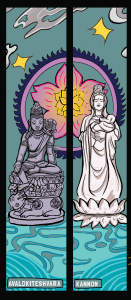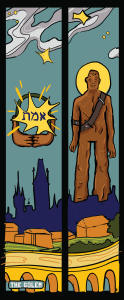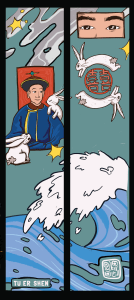This is a blog by Roger Kim, Blythe Yoshikane, and the Every Month is Pride Month team

To coincide with one year of monthly pride programming, San Lorenzo Library is unveiling a new mural celebrating queer mythologies from different cultures. Muralist Blythe Yoshikane, a recent graduate from California College of the Arts, was inspired by tales of trans and bisexual gods and goddesses from their Hawaiian and Filipino heritages to search for queer episodes in the myths of other cultures. Yoshikane shares, “the queer experience is a cosmological truth.”
The mural was designed by Blythe Yoshikane, and painted by Krishnaa Nair, Brian Kwon, Tony Bernardo, Jillian Ikehara, Angie Romero, Malia Valesco, Astrid Hernandez, and Blythe Yoshikane.

Hiʻiakaikapoliopele and Hopoe
Hi’iaka is the Hawaiian goddess of hula and oli (chants), and the youngest sister of Pele, the goddess of volcanoes and fire. One day, Hi’iaka came across a beautiful dancing woman named Hopoe. In some retellings, this is the first time Hi’iaka saw the dance of hula. Hi’iaka asked Hopoe if she would become her aikane, a beloved partner of the same gender. The two fell in love while Hopoe taught Hi’iaka ancient hulas and how to make lei. Out of rage towards her sister, Pele flooded the shore of Puna with lava, the area where Hopoe resided. However, Hopoe did not perish and instead was preserved as a stone that would continue to dance and move on the shore when the waves move her. The ‘olelo no’eau (Hawaiian proverb) from on the mural translates to:
Protect the people. Protect the flower. Protect the place where we love.

Lakapati
Lakapati, the Filipino goddess of fertility is depicted sometimes as transgender and sometimes as hermaphrodite with both male and female genitalia. She is known as a goddess of compassion and harvest. Those who worship her offer her plates of rice and herbs so that she would return them with bountiful crops. Some Buddhists in the Philippines compare Lakapati, Mother Earth, to Guanyin or Kannon, the bodhisattva of compassion shown in the following panels. In one Filipino creation story, Lakapati provided the clay from which Bathala, the supreme god who is also of ambiguous gender, created the world. Lakapati then took the world, placed it in the sky, and called it Earth.

Avalokiteshvara and Kannon
The Bodhisattva Avalokiteshvara is said to contain the compassion of all Buddhas and to have several different avatars, both male and female. Representations of Avalokiteshvara originated in northwestern India and depicted him as masculine. As Buddhism spread throughout time and place towards Eastern Asia, depictions of Avalokiteshvara became more feminine. In China, she is known as the goddess Guanyin. In Japan, where she is called Kannon, her feminine traits were further emphasized and she became associated with motherhood.

Golem
There are several Golem stories in Jewish mythology. In many of the stories, the Golem is created out of clay to be a protector but eventually must be deactivated or destroyed as it gets out of control. In recent times, queer artists have claimed the Golem as a queer Jewish icon, as a representation of “otherness” and the perception of monstrosity.

Tu ʻEr Shen
Hu Tianbao, a man from Fujian, fell in love with a visiting official. He was caught spying on the official and was sentenced to death for his offense. After his death, Hu protested to the gods of the underworld that his death on Earth was unjust. As a result, he was transformed into Tu ‘Er Shen, rabbit god and heavenly protector of gay relationships. Depending on who you ask, the story of Tu ‘Er Shen originates from a 17th-century folktale or is the invention of an 18th-century poet. Either way, Tu ‘Er Shen has become an important symbol of the Taoist LGBTQ community.


Add a comment to: Queer Mythologies Mural at San Lorenzo Library